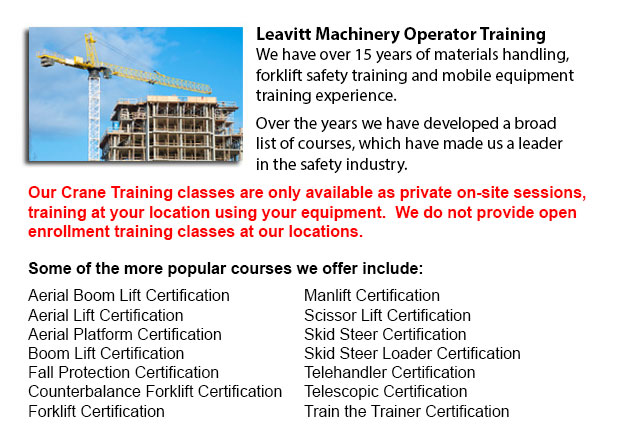
Crane Certification Penticton - The Crane Certification training program covers subject matter recommended by industry concerning the efficient and safe operation of cranes. Individuals training would be taught the following: how to identify cranes and their component parts; pre-operational, operational and post-operating requirements; rigging components and inspection/rejection criteria; how to determine overall lift capacity; and requirements particular to the work place where the trainees would be operating.
The requirements that should be carried out before operating a crane includes assigning authority for the pre-operational check; performing the sequential pre-operational check based on the specifications certified by a professional engineer or manufacturer's specifications; checking the work area for obstacles and hazards; checking the log book for comments; checking chains, cables, hooks safety latches and crane movement; ensuring the correct functioning of operational controls; and learning how to ensure the disconnect switch/isolator of the crane is properly functioning.
Operational requirements include identifying roles and responsibilities, and determining the need for a formal lift plan. Individuals training would know how to perform a hazard assessment associated to environmental situations, physical conditions and staff. Subject matter includes determining when to seek competent help, the safest route and destination of loads, and centre of gravity and load weight.
Individuals training should be able to identify an over-capacity lift, in addition to be able to choose correct rigging equipment, choose load limitations, and to determine the safe location for the crane to work from. Trainees would review both universal and site-specific crane signals for lifts, and methods for lifting, loading and traveling. Proper maintenance practice will likewise be included.
The trainee would undergo an examination to test their understanding of emergency response procedures for different scenarios, specially mechanical or electrical failures. They will be asked to describe shut down and parking procedures for security and safety, to follow lock out and tagging procedures, and to explain the reason why near misses are reported and recorded to the appropriate person. Log book records should be maintained.
Individuals training will develop knowledge of rigging, in particular, establishing who has responsibility and authority for rigging, identifying various types of rigging, knowing load capacity ratings and storage procedures.
Post-operational requirements consist of entering deficiencies or defects, service and maintenance history within the log book, based on Federal, state and provincial codes requirements.
Site-specific requirements can be incorporated into the safety training program based on the employer's needs.
-
Forklift Certification Schools Penticton
Forklift Certification Schools Penticton - In North America, forklift certification is mandatory, making forklift training programs essential for both the business and their employees working as operators of forklifts. Forklift training focuses on sa... More -
Telehandler Training Courses Penticton
Telehandler Training Courses Penticton - The employer has the responsibility to make sure that their personnel are trained to work proficiently utilizing telehandler machinery. The workers have to be assessed for their ability to utilize the machine.... More -
Certified Fall Protection Training in Penticton
There are many injuries at work linked to falling and lots of fall-related deaths reported each and every year. Most of these instances might have been prevented with better training, better precautions in place, and by properly equipping employees b... More -
Zoom Boom Training Penticton
Zoom Boom Training Penticton - Zoom Boom Training is designed to train operators on variable reach forklifts. The objectives of the training are to impart an understanding of the physics of the machine, and to outline the operator's job. This course... More -
Crane Training Schools Penticton
Crane Training Schools Penticton - We have designed various Mobile Crane Operation programs at our Crane Training Schools. These programs are recommended for the experienced operator who needs re-certification or certification, and for inexperienced... More -
Aerial Lift, Boom Lift, Man Lift, Scissor Lift Training in Penticton
Lift tables or also referred to as scissor hoists can lift up both individuals and materials vertically. They are normally utilized in industrial, construction and commercial environments. Normally, the use of a scissor forklift is to lift and lower... More -
Forklift Training Program Penticton
Forklift Training Program Penticton - The forklift is a common powered industrial vehicle which is in wide use nowadays. They are occasionally known as hi los, lift trucks or jitneys. A departments store will utilize the forklift to unload and load m... More -
Overhead Crane Training Penticton
Overhead Crane Training Penticton - An overhead crane is a large crane used to move and lift huge, heavy objects that cannot be lifted by hand. An overhead crane is normally fixed in position while in use. These machines are capable of moving huge vo... More

Forklift Training Penticton
TOLL FREE: 1-888-254-6157
Penticton, British Columbia
forklifttrainingpenticton.com
Email Us
About Us


